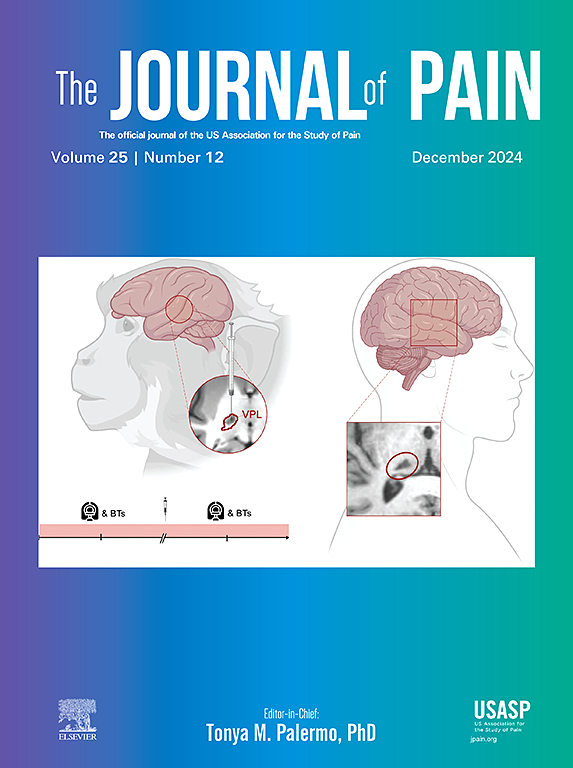Eight-year chronic pain trajectory and risk of cardiovascular disease: Evidence from 10 years of multicenter follow-up
IF 4
2区 医学
Q1 CLINICAL NEUROLOGY
引用次数: 0
Abstract
Previous studies have shown that chronic pain is associated with an increased risk of cardiovascular disease. However, there are no studies reporting the relationship between chronic pain trajectories and cardiovascular disease. The pooled data from two prospective cohorts, the Health Retirement Study (HRS) and the English Longitudinal Study of Ageing (ELSA), were included in this study, and five chronic pain trajectories were established based on eight years of follow-up. Cox proportional risk regression models were used to assess the association between different chronic pain trajectories and cardiovascular disease. A total of 19,234 participants were included in the study and were followed for 10 years. With the no pain trajectory as the reference group, increasing pain (HR:1.41, 95% CI: 1.24–1.61) and consistent pain (HR:1.27, 95% CI:1.14–1.43) trajectories were all significantly associated with an increased risk of cardiovascular disease. Conversely, the decreasing pain (HR:1.04, 95% CI:0.90–1.21) and fluctuating (HR:1.02, 95% CI:0.95–1.10) trajectory was not significantly associated with cardiovascular disease. However, no significant association was observed between chronic pain trajectories and stroke risk. The present study demonstrates that both increasing and consistent pain trajectories are significantly associated with an elevated risk of cardiovascular disease. In contrast, decreasing pain trajectories were not associated with cardiovascular risk. Therefore, incorporating chronic pain assessment into cardiovascular disease management is warranted.
Perspective
This longitudinal study highlights the importance of chronic pain trajectories in predicting cardiovascular disease. Findings support the integration of long-term pain patterns into cardiovascular risk assessments to improve prevention and management strategies.
8年慢性疼痛轨迹与心血管疾病风险:来自10年多中心随访的证据
先前的研究表明,慢性疼痛与心血管疾病的风险增加有关。然而,没有研究报告慢性疼痛轨迹和心血管疾病之间的关系。本研究纳入了来自健康退休研究(HRS)和英国老龄化纵向研究(ELSA)两个前瞻性队列的汇总数据,并在8年随访的基础上建立了5种慢性疼痛轨迹。采用Cox比例风险回归模型评估不同慢性疼痛轨迹与心血管疾病之间的关系。共有19234名参与者参与了这项为期10年的研究。以无疼痛轨迹为参照组,疼痛轨迹增加(HR:1.41, 95% CI: 1.24-1.61)和持续疼痛(HR:1.27, 95% CI: 1.14-1.43)均与心血管疾病风险增加显著相关。相反,疼痛减轻(HR:1.04, 95% CI: 0.90-1.21)和波动(HR:1.02, 95% CI: 0.95-1.10)轨迹与心血管疾病无显著相关性。然而,没有观察到慢性疼痛轨迹和中风风险之间的显著关联。目前的研究表明,增加和持续的疼痛轨迹与心血管疾病的风险升高显著相关。相比之下,疼痛轨迹的减少与心血管风险无关。因此,将慢性疼痛评估纳入心血管疾病管理是必要的。这项纵向研究强调了慢性疼痛轨迹在预测心血管疾病中的重要性。研究结果支持将长期疼痛模式纳入心血管风险评估,以改善预防和管理策略。
本文章由计算机程序翻译,如有差异,请以英文原文为准。
求助全文
约1分钟内获得全文
求助全文
来源期刊

Journal of Pain
医学-临床神经学
CiteScore
6.30
自引率
7.50%
发文量
441
审稿时长
42 days
期刊介绍:
The Journal of Pain publishes original articles related to all aspects of pain, including clinical and basic research, patient care, education, and health policy. Articles selected for publication in the Journal are most commonly reports of original clinical research or reports of original basic research. In addition, invited critical reviews, including meta analyses of drugs for pain management, invited commentaries on reviews, and exceptional case studies are published in the Journal. The mission of the Journal is to improve the care of patients in pain by providing a forum for clinical researchers, basic scientists, clinicians, and other health professionals to publish original research.
 求助内容:
求助内容: 应助结果提醒方式:
应助结果提醒方式:


